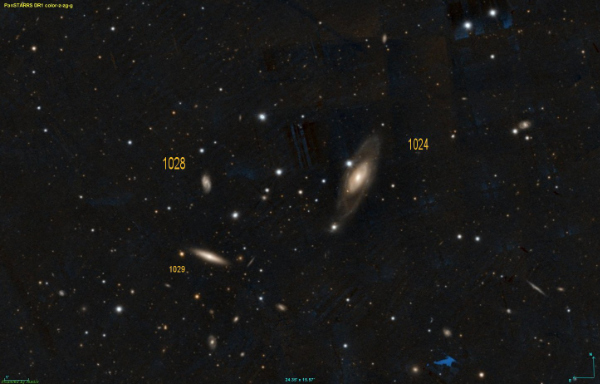NGC 1024 in Aries
December 2018 - Galaxy of the Month

NGC 1024 is part of a group of three galaxies, including NGC 1028 and NGC 1029.
First discovered by William Herschel in 1786, NGC 1024 was included by Arp in his catalogue of peculiar galaxies as number 333, under the classification of Miscellaneous galaxies. Arp classified it as such because it had very thin spiral arms coming from a pseudo ring. As such it does have the very complex morphological classification of (R')SA(r)ab. NGC 1028 and NGC 1029 are very much fainter and were first discovered by Albert Marth using William Lassell’s 48” reflector from Malta.
There are some issues over whether the group is physically related and it is included in the WBL catalogue as number 82. The WBL group only consists of these three galaxies. Just to show how confusing cataloguing groups of galaxies is, the NGC 1024 group is also included in the LGG catalogue as number 69. The LGG group also makes the group count as three galaxies, but in this case NGC 1024 and NGC 1029 make the cut and NGC 1028 is dropped from the group to be replaced by the elliptical galaxy NGC 990, which is over a degree away on the sky.
If you look at the redshifts of the galaxies then the redshift for NGC 1028 is more than twice that for NGC 1024 and NGC 1029, whilst that for NGC 990 is pretty much the same, as always showing that proximity on the sky is no substitute for proximity in space.
At the very least NGC 1024 is thought to form a physical pair with NGC 1029. NGC 1029 is classified as a lenticular galaxy whilst NGC 1028 appears to be a Sa spiral.
The NGC 1024 group is thought to be about 158 million light years away.
Visually NGC 1024 will be challenging in 20-cm but should be visible relatively easily in 37cm. The companions are going to be a challenge I think for 37cm and may require 50cm to see easily. The three NGC galaxies are a tight group and you may need to use medium to high power to cleanly separate them.
For masochists there is also a much fainter (16th magnitude) galaxy in the field known as LEDA 1385855. Steve Gottlieb suggests that even in his 17.5” both NGC 1028 and NGC 1029 are pretty faint.
There is a 7th magnitude star close by the group which will need to be kept outside the field in order to pick up the fainter members I would think.
Owen Brazell - Galaxy Section Director